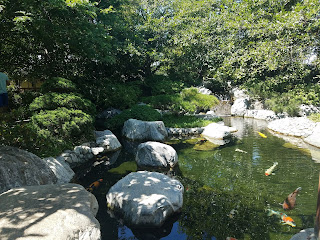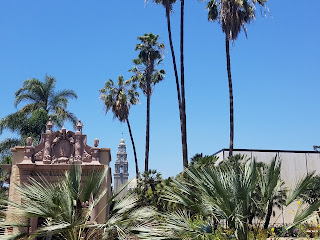Balboa Park (July 2018) -
Be Sure to Visit this Cultural Gem!
My spouse and I visited
Balboa Park on a Thursday morning in early July 2018. You can access the park
grounds freely; there is no admission fee unless you enter the
buildings/museums.
Balboa Park is a 1,200-acre area with open spaces, natural
vegetation and gardens, and walking paths that provide the backdrop for many
museums, theaters, the zoo, recreational facilities, gift shops, and
restaurants. It is one of the oldest parks in the country dedicated to public
recreational use. San Diego was the second city in the US to create such a
park, after the construction of NYC’s Central Park in 1858. Originally called
City Park, Balboa Park was later renamed in honor of Spanish maritime explorer
Vasco Nunez de Balboa, the first European to cross Central America and see the
Pacific Ocean. Originally owned by Spain and Mexico, the land for Balboa Park
was ceded to California after the Mexican-American War.
In 1915, the park hosted its first large event: the Panama-California
Exposition to commemorate the opening of the Panama Canal. (San Diego was the
first US port of call that ships encountered after passing through the canal
and sailing north.) Its second big event was the California Pacific
International Exposition of 1935 to promote the city and help it recover from
the Great Depression. Both major events created some architectural landmarks
that still exist in the park today. In 1977, the park and its historic exposition
buildings were declared a National Historic Landmark District and placed on the
National Register of Historic Places. Although never intended to be permanent
buildings, some of the original infrastructure remains, including the Cabrillo
Bridge, California State Building and Quadrangle (now the San Diego Museum of
Man), Administration Building (now offices of the Museum of Man), Botanical
Building, California Bell Tower, New Mexico Building (now the Balboa Park
Club), and the Spreckels Organ Pavilion (John Spreckels owned the San Diego
Electric Railway streetcar system). During World Wars I and II, the park was
used by the Department of the Navy as hospital wards, barracks, and training
grounds.
Balboa Park museums include those dedicated to art, air and space, science,
photography, cars, history, natural history, model trains, and veterans. You
can also tour houses including the George W. Marston House and the House of
Pacific Relations International Cottages. Gardens feature prominently in the
park, including those dedicated to children’s ethnobotany, native plants, cacti,
roses, lilies, and palms. (We toured the Japanese Friendship Garden; see our
separate review.) You can also visit the carousel, world-famous zoo, stadium,
symphony, theatre (a replica of Shakespeare’s Globe), puppet theatre, art
center, amphitheater, and sports complexes (including golf courses, baseball
and softball fields, tennis courts, archery ranges, and a swimming pool). Many
of the museums occupy gorgeous Spanish Baroque/Colonial Revival buildings that
line El Prado, a long wide promenade that includes two continuous covered
arched arcades/walkways along a pedestrian boulevard that runs through the
center of the park. One particular architectural gem is the Botanical Building,
which was the largest wood lath structure in the world when it was built in
1915; it contains large specimen palms and other plants and sits next to a long
reflecting pool. Other attractions include outdoor chess and bridge tables, horseshoe
pits, playgrounds, walking/jogging paths, sports fields, and picnic areas. A
few restaurants/food concessions are located in the park, including Panama 66 (P66
at the San Diego Museum of Art [SDMA]),
The Prado, and the Tea House outside the Japanese garden. (See our separate
reviews for Panama 66 and The Prado.)
We enjoyed our day spent
strolling in Balboa Park. Even though we didn’t visit the interiors of any
buildings, it was enough to admire the magnificent structures from the outside.




























No comments:
Post a Comment